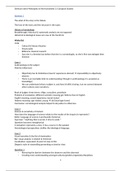Seminar notes Philosophy of the Humanities 2: European Studies
Seminar 1
The what of the story is the fabula.
The how of the story and the structure is the sujet.
History of narratology
Breakthrough: historical & systematic analysis are not opposed
Historical & ideological issues are now at the forefront.
Mieke Bal
1946
- Cultural & literary theories
- Structuralist
- Biblical & classical research
- Says she is a feminist but before that she is a narratologist, so she is first narratologist then
feminist
Case 1
Anthropology & the subject
Alterity (otherness)
- Objectivity has its limitations (Geertz’ experience abroad) impossibility to objectively
observe
- There is an inevitable limit to understanding (Though in anthropology it’s accepted as
knowledge)
- We can understand what a subject is, and how it fulfils is being , but we cannot interpret
other cultures own narratives.
Book of judges: three terms: vifign, concubine, prostitute
Problem of translation: different semiotic meaning gin Hebrew than in English
English meaning: sexual experience (social status)
Hebrew meaning: age related, young old (marriage forms)
Conclusion: narratological analysis helped to do justice to otherness.
Case 2
Science & narrativity of rhetoric
How does the language of science relate to the results of the inquiry it represents?
Keller: language of science is profoundly rhetorical
Feynman: “anything that is secret, it tries to undo.”
Question becomes metaphorical
A metaphor represents a view, it has a source in the speaker
Narratological perspectives clarifies the ideological language.
Case 3
Visual narrative & the fist of domination
Bal: visual analysis is related to feminism
Focalisation: equivalent of point of view in film
Diegesis: style of storytelling presenting an interior view.
Question 1
- Removing the barriers between the observer and the observed
- Creating more understanding amongst cultures/genders/opposites/disciplines
1
,Seminar notes Philosophy of the Humanities 2: European Studies
Question 2
Geographical: Geert: you cannot completely describe another culture’s habits and gestures in an
objective way
Biblical: book of judges: temporal aspects also play a role in narratology.
Question 3
1. Anthropology & the subject
- Objectivity and its limitations (Geertz’ experience abroad) impossibility to objectively
observe
Conclusion
Range of narratology – go beyond textual analysis
Anthropology, science and visual narratology can cover multiple disciplines
Narratological perspectives can e formed on ideological issues
Feminism can use narratology to counter simplistic arguments against it
There is a connection between narratology and history
(the way of given women certain status in Judges in anachronistic)
White
- Historian
- Essayist
Genres
- Satire
- Comedy
- Tragedy
- Romance
- Heroic story: epic
o Leopold von Ranke
Narrative history
Literary style
Tropes
Metaphor
- Simile
- Highlighting similarities
Metonymy
- Highlighting differences
Synecdoche
- Pars pro toto
- Totum pro parte
Irony
Emplotment
Assembly of series of historical events into a narrative with a plot
Create understandable coherent story
- Link with literary texts
Explanatory effect
(re)familiarize the unfamiliar.
Framing of historical narrative
Constructive imagination
2
,Seminar notes Philosophy of the Humanities 2: European Studies
- Link with Humboldt’s notion of artistic ‘creativity’ and ‘intuition’
Giving ‘meaning’ to historical events
- Value-neutral vs. ‘tragic’ or ‘romantic’
- Fiction-making operation
Inclusion vs. exclusion of events
Mediative function
Chronology &emphasis
- a, b, c, d, e,….
- A, b, c, d, e, …
o Deterministic
Emphasis on the beginning
- a, B, c, d, e, …
- a, b, c, d, E, …
o eschatological (apocalyptical)
emphasis on the last period
Seminar 2
Leerssen
Nationalism
Desire to achieve harmony between state and nation, state borders and cultural frontiers, which
mainly thrived during romantic idealism
Aims for its own sovereign state, 1 nationality.
Linked to federalism:
- Anti-idealistic: pragmatic alternative nationalism
- Opposes national state organization
- Multicultural & liberal
- pattern national through: administrative & cultural units matching.
European diversity
‘Ramshackle’
2 main arguments: absurd to say Europe has unifying property that Europe has no unifying property
at al
- Linking diversity to the notion of liberty
- Authoritarian Gleichschaltung
- Federal structure, nonetheless, has still national thought structure to it.
- Maintaining diversity
- Pattern National Thought.
Modular view & typicality effect
See Europe as diverse concept with diverse building blocks. Blocks give wrong interpretation of
diversity in Europe. Borders are recent phenomena and do not represent well the cultural borders.
Modular view:
- Europe as different building blocks
- National schemes
- Fuzzy borders
- Cross-cultural comparisons/contradictions
Typicality effect:
3
,Seminar notes Philosophy of the Humanities 2: European Studies
- Intensifying nation characteristics stereotypes & polarization
- Wrong oversimplification of reality
- Popper
- Centuries old and often don’t exist anymore.
- Typicality effect lies in modular view
Isoglosses
Think of it as a map.
Isoglosses not same as dialects.
Discontinuity in speech practice (dialects)
- Europe as consisting of dialectical continuums, divided by isoglosses. Dialect change in
character but in slow pace
Difference modular view:
- Modular view creates borders based on differences between, and dependency of, a set of
units that are part of a whole, whilst isoglosses considers a set of autonomous borders
- isoglosses = not a set of units, but a set of borders
Political vs. cultural borders
Isoglosses considered cultural borders
Political:
- Fixed (prevents empty lands)
- Changeable/temporarily turbulent
- Puzzle
Cultural:
- Fuzzy
- Relatively stable
e.g. Czech Republic and Slovakia: culturally very similar but politically very different.
Kahoot
Democracy linked to federalism. But there are still small units in federal states that are still supported
by national thought.
Leerssen rejects units but need to see it as a set of borders.
Spariosu
Liminality
Large-scale society
Transition phase form one situation to another. In between two steady states. Go from structure to
anti-structure/dissolve to again structure.
Process that doesn’t depend on willingness of the actors involved. Transition that happens
independently on your will
In literature – bridge helping us to mentally reach the alternative reality literature = liminal
- Marginality: e.g. : reading a book in classroom: you are in the class room but through the
book you come into another world (also to do with heterotopia of Foucault).
Centre vs. periphery
4
, Seminar notes Philosophy of the Humanities 2: European Studies
Rite of passage: specific ritual to go from one phase of life to another.
Liminality is more complied on big community.
Three stages in rite of passage
Separation transition : margin/limen, limbo, rite of passage ( = transition in ritual), anti-structure)
incorporation: new stable position
Liminoid
Rather on individual basis, specific community
Whereas liminality is more of a process, liminoid a commodity
e.g. Amish: is given the opportunity to decide if they want to continue being Amish or go into the
‘normal world’. = change of world.
Turner – flaws
Using these concepts interchangeably: same with verbs play and work
Spariosu suggests liminality should be defined as directly interconnected system and marginality as
relatively separated structure.
Vs.
Turner’s fuzzy view that marginality can sometimes redefine centre whereas liminality may lead us
away from it.
Western literary theory
Literature has been used as a tool for individuals to connect with the abstract: supporting
marginality, foremost liminal
Antiquity: from oral to literature.
Renaissance: tragedy/tragic poetry as a tool of distinguishing true and false + relation between
history & philosophy. Literature liminal for reality and fiction (poet is not a liar)
Romanticism: reason & imagination
Now: becoming & literature as liminal and marginal
Leerssen:
- Wrote the text in 1993: Maastricht treaty .
- Starts with smack on the face: use of ramshackle.
- Looking at role that languages play
- Isoglosses is a way of mapping. It is how you are looking at it. Uses isoglosses to look at the
dialects. Tool to map.
Spariosu
- Anthropological text
- Basing argument on Turner.
- Liminality is for large-scaled society
- Liminoid is for small-scaled society
- Spariosu picks liminality over liminoid. Can use liminality in multiple cases. Leave liminoid.
Seminar 3
Anderson
- Born in China
- Indonesian, Dutch, Japanese
- Banned form Indonesia
Context when book was published:
5





